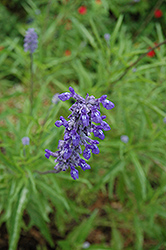It's all about ...
plants

Plant Height: 15 inches
Flower Height: 24 inches
Spacing: 10 inches
Sunlight:
![]()
Hardiness Zone: (annual)
Other Names: Lyre-Leaf Sage, Cancer Weed
Description:
Lovely mounds of green lobed foliage that develop deep purple veins; lavender blue flowers in spring; perfect for borders and containers; dramatic when massed as a groundcover in sunny areas
Ornamental Features
Lyreleaf Sage's attractive crinkled lobed leaves are green in colour with distinctive deep purple veins on a plant with a low base above which the flowers rise. As an added bonus, the foliage turns a gorgeous plum purple in the fall. It features delicate spikes of lavender flowers with blue overtones rising above the foliage from late spring to mid summer.
Landscape Attributes
Lyreleaf Sage is an herbaceous annual with tall flower stalks held atop a low mound of foliage. Its medium texture blends into the garden, but can always be balanced by a couple of finer or coarser plants for an effective composition.
This plant will require occasional maintenance and upkeep, and is best cleaned up in early spring before it resumes active growth for the season. It is a good choice for attracting bees, butterflies and hummingbirds to your yard, but is not particularly attractive to deer who tend to leave it alone in favor of tastier treats. Gardeners should be aware of the following characteristic(s) that may warrant special consideration;
- Self-Seeding
Lyreleaf Sage is recommended for the following landscape applications;
- Mass Planting
- Border Edging
- General Garden Use
- Groundcover
- Container Planting
Planting & Growing
Lyreleaf Sage will grow to be about 15 inches tall at maturity extending to 24 inches tall with the flowers, with a spread of 12 inches. When grown in masses or used as a bedding plant, individual plants should be spaced approximately 10 inches apart. Its foliage tends to remain dense right to the ground, not requiring facer plants in front. Although it's not a true annual, this fast-growing plant can be expected to behave as an annual in our climate if left outdoors over the winter, usually needing replacement the following year. As such, gardeners should take into consideration that it will perform differently than it would in its native habitat.
This plant should only be grown in full sunlight. It is an amazingly adaptable plant, tolerating both dry conditions and even some standing water. It is considered to be drought-tolerant, and thus makes an ideal choice for a low-water garden or xeriscape application. It is not particular as to soil pH, but grows best in clay soils. It is somewhat tolerant of urban pollution. Consider applying a thick mulch around the root zone in winter to protect it in exposed locations or colder microclimates. This species is native to parts of North America. It can be propagated by division.
Lyreleaf Sage is a fine choice for the garden, but it is also a good selection for planting in outdoor pots and containers. With its upright habit of growth, it is best suited for use as a 'thriller' in the 'spiller-thriller-filler' container combination; plant it near the center of the pot, surrounded by smaller plants and those that spill over the edges. Note that when growing plants in outdoor containers and baskets, they may require more frequent waterings than they would in the yard or garden.
